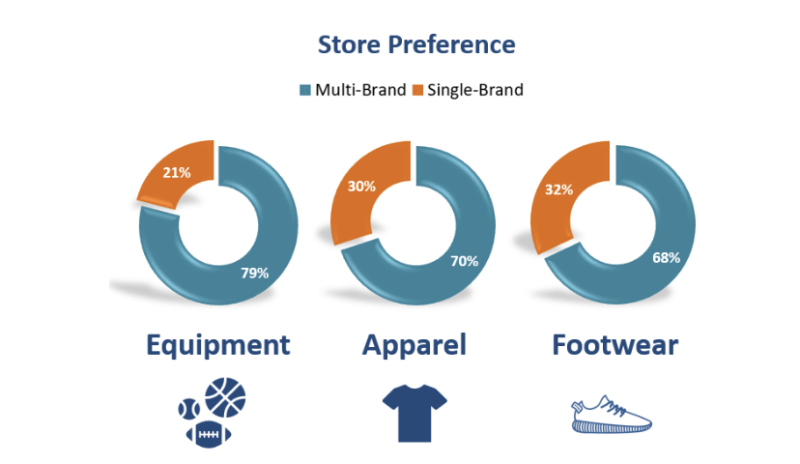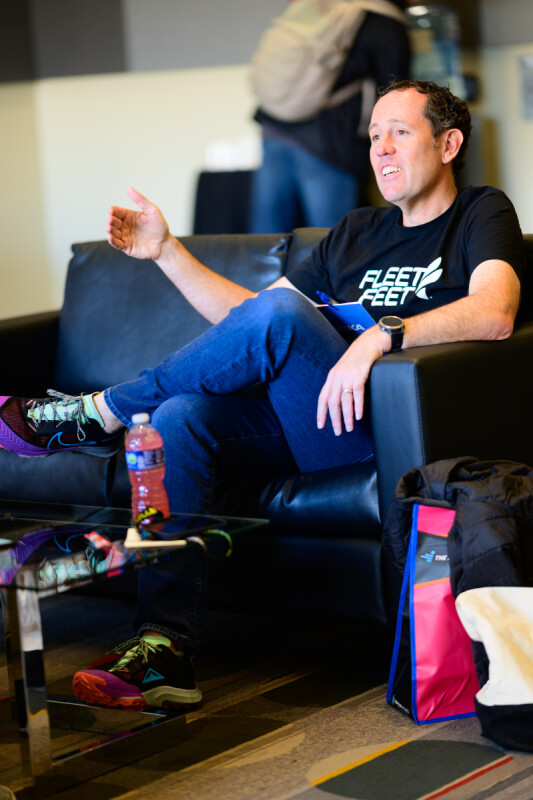At the conclusion of their operation’s marathon training program in Spring 2018, Fleet Feet Madison, WI, owners Matt and Jessica Anderson thought they’d take a shot and continue the ongoing routine of group runs, albeit with a twist.
Optimistic that trail running could become a greater part of the local vernacular in and around Wisconsin’s capital city, the Andersons plotted a trio of trail runs designed to introduce people to local off-road venues. Then, they spread the word, hopeful they might get a few takers.
To the Andersons’ surprise, 50 people attended the first trail run Fleet Feet Madison hosted at the University of Wisconsin Arboretum in June 2018.
“Completely unexpected,” says Matt Anderson, who owns a second Fleet Feet shop in the Madison suburb of Sun Prairie. “It showed the interest was there for trail running, which was something we could build off.”
Over recent years, the Andersons have added a formal 10-week trail running program – the aptly named Dairyland Dirtbags to their company’s arsenal – while also shining a brighter light on trail running products in their run shops and actively promoting trail running as a dynamic alternative to the roads.
“Trail running’s a growth area for us, and something we believe can be even bigger,” Anderson says.
Trail Running Surges
Earlier this year, International Trail Running Association president Bob Crowley wrote in UltraRunning magazine that trail running has recorded 12 percent year-over-year gains globally for over a decade now while becoming younger and more diverse in the process.
“There are no signs of that trend abating,” Crowley wrote. “In fact, the pandemic has only accelerated interest in the great outdoors and trail running stands as one of several segments to benefit.”
For many, the trails offer a healthy escape into nature and a welcome opportunity to detach from an increasingly digital world. For others, trail running is a more forgiving alternative to the roads and a way to spice up training.
Whatever the driving reason, trail use is growing across the U.S. – and not just in trail running hotbeds like Boulder or Moab or Flagstaff. According to popular mobile app AllTrails, New Jersey, Massachusetts, Connecticut, Illinois, Wisconsin, Delaware, Kansas, Minnesota and Iowa – none of which sit top of mind among America’s premier trail destinations – all saw trail activity climb over 200 percent from pre-pandemic figures to recent times.
The mushrooming numbers of people hitting the trails across the U.S. presents a compelling business opportunity for run shops to deepen their ties with local runners, expand their audience and propel revenue through sales of less ubiquitous product. To capitalize on this opportunity, though, run shops must take intentional steps to promote participation and champion the trails – and especially so in markets in which trail running isn’t embedded in the local athletic DNA.
So, how might run shops tap into rising interest in the trails?
- Offer a simple, non-threatening invitation.
Trail running can be a daunting adventure, which is why many run shops have developed entry-level programs designed to introduce athletes to the trails in small doses. This helps counter the idea that trail running is only for the ultrarunners.
Ohio-based Second Sole has hosted numerous group runs to draw locals into the splendid, though oft-overlooked trail running environment in northeast Ohio. The short, social runs get people familiar with basics, like where to park, where to start, the courses and general safety.
“The first step is making sure local runners know the trails that are available,” Second Sole general manager Dylan Dombi says.
In Pasadena, CA, Run With Us regularly hosts meetups at local trailheads. The shop’s Sunday Trail Runs feature three distinct groups for experienced and novice participants alike to embrace the trails: one group hits 10-plus miles, another runs six-to-eight miles and a third group hikes.
Even along Colorado’s Front Range, the Berkeley Park Running Company doesn’t assume every runner is prepared to tackle the trails. On Aug. 16, for example, the four-year-old run shop held a “Learn to Mountain Jog” event at North Table Mountain Park. The comparatively modest 4.3-mile jaunt included an invitation to post-run beverages at New Terrain Brewing Company.
- Develop formal trail running programs.
On Aug. 9, Fleet Feet Madison launched the latest installment of its Dairyland Dirtbags trail run training group. Capped at 30 people, the group meets once each week at different local trails through Oct. 10. Group coaches share tips on how to run the trails and also spotlight valuable gear. While the program typically culminates in a trail race, this fall’s session will conclude with a camping event and trail run.
In Alabama, meanwhile, Fleet Feet Huntsville hosts three different trail running programs, including the soon-to-start, eight-week Rock Runners program that prepares participants to tackle the seven-mile Oak Park Challenge on Halloween morning. In the $100 program, athletes get advice and support from experienced coaches, a weekly group training run and clinics on topics such as trail safety, proper nutrition, choosing the right gear and avoiding injury.
- Tie the trails to something bigger.
The trails naturally spark deeper connections with the environment and, often, with oneself, something run shops have highlighted in different ways. Some stores, for instance, host plogging events that blend running or walking with trail cleanup; others have tied sales of trail product, whether footwear or store-branded merchandise, to conservation or environmental causes.
This Sept. 5, Two Rivers Treads in West Virginia has planned a “Take It to the Trails” event that includes a full day dedicated to promoting the benefits of being outside. The schedule includes a women’s only trail run with Trail Sisters and a “Leave No Trace” workshop as well as a presentation on the healing power of nature.
- Go far out.
Northern California’s Healdsburg Running Company has combined people’s passion for running, food, drink and travel into its trail running camps, which pair captivating trail runs with intimate food and beverage experiences in California wine country.
“As the world goes online, what will you go online with? I believe it can’t just be product, but special experiences that make you something unique and different,” Healdsburg Running Company owner Skip Brand says.
On the weekend of Sept. 11, Run With Us will host its Trail Camp, which will include runs at the Angeles National Forest, camping at the Chilao Campground and battle-tested advice for completing an ultrarunning event.
Another California running store, Fleet Feet Aptos, held a Trail Shark Adventures program that provided runners round-trip transportation to a supported trail run and gourmet meal.
- Invest in the trail category.
For running retailers, it’s tough to promote trail running and reap the benefits of doing so without offering the product that makes trail running a more enjoyable and safe experience.
When Dink and Suzanne Taylor opened Fleet Feet Huntsville 18 years ago, Dink, an avid trail runner, made the conscious decision to carry trail product even though trail running was, at best, a niche local activity at the time.
“We were betting it’d grow, and it did,” Dink Taylor says.
Today, customers travel to Fleet Feet Huntsville from upwards of 100 miles away to try and test the latest and greatest trail-running models. The store stocks more than 20 trail shoes from brands such as The North Face, Saucony, Brooks and New Balance as well as other trail-oriented gear, including hydration packs, belts and bottles as well as apparel.
In addition, Fleet Feet Huntsville sponsors key events from Running Lane, a local timing company that specializes in trail races. The sponsorships often include in-store packet pickups that expose participants to Fleet Feet Huntsville’s diverse array of trail products.
“And there’s no doubt we get sales from that,” Taylor says.
- Put trail running front and center.
At different times over recent years, Second Sole has devoted a table at the front of its stores to different trail-oriented gear, including footwear, gaiters, hydration packs and nutrition. Some Second Sole stores also have an entire area dedicated to local trail maps that bring attention to area venues.
When the Andersons expanded their flagship Fleet Feet Madison store in 2017, they created a defined trail shoe wall backed by an outdoorsy graphic. Previously, Matt Anderson says, trail shoes would often be relegated to the bottom of the shoe wall.
“Once we knew we were going to have more room, we found a way to highlight our trail footwear,” he says. “It piques curiosity and leads to conversation.”
Trail shoe demo runs or Gore-Tex sample kits that show the technology’s waterproof qualities can also bring interactive attention to trail product, if not gear that can work well on the road during sloppy, cold or wet days as well.
“You have to make it a call out,” Second Sole’s Dombi says. “It’s one important way to generate interest and get people talking.”
A surge in trail use
Source: AllTrails
10 states that saw the highest jump in trail use
- New Jersey: 226%
- Delaware: 224%
- Connecticut: 219%
- Kansas: 215%
- Massachusetts: 212%
- Minnesota: 211%
- Iowa: 208%
- Illinois: 205%
- Wisconsin: 202%
- (tie) Pennsylvania, Michigan, and Rhode Island: 195%
10 venues that saw the highest jump in trail use
- Allamuchy Mountain State Park (New Jersey): 504%
- Turkey Run Park (Virginia): 468%
- Norvin Green State Forest (New Jersey): 466%
- Rockefeller State Park Preserve (New York): 408%
- Bigelow Hollow State Park (Connecticut): 397%
- Clarence Fahnestock State Park (New York): 387%
- Schooley’s Mountain Park (New Jersey): 380%
- Hidden Valley Preserve (Connecticut): 367%
- Ward Pound Ridge Reservation (New York): 367%
- Day Pond State Park (Connecticut): 362%







